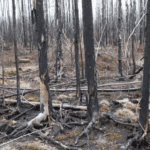In July 2023, mammal researchers from all over the world met in Anchorage, Alaska for the 13th International Mammalogical Congress (IMC), a joint conference between the International Federation of Mammalogists (IMC) and the American Society of Mammalogists. Last held in 2017 in Perth, Western Australia, the IMC brings the latest in ‘all things mammalian’ together for a week-long scientific program. As the journal development specialist for the Canadian Journal of Zoology (CJZ) and as a mammal researcher myself, I couldn’t wait to visit Alaska for the week!
Celebrating mammals in the Canadian Journal of Zoology
With a program boasting nearly 600 talks, posters, and plenaries from researchers all over the world, IMC was truly an international congress. Twenty symposia brought together leading and emerging researchers on topical themes including mammalian responses to climate change, physiological tradeoffs in female reproduction, and the role of social bonds in ungulate movement ecology. Virtual technical sessions allowed greater participation and even more presentations, substantially increasing the amount of cutting-edge research being shared and discussed.
The Canadian Journal of Zoology has been publishing mammal research since the 1930s, when it was still part of its multidisciplinary precursor, the Canadian Journal of Research.
From mapping evolutionary origins to modeling future biodiversity, the staggering diversity in topics discussed at IMC reaffirmed how science builds and grows on itself. With physiological, genetic, behavioural, microbiotic, and ecological elements to consider, there are so many connections to explore, even within a single class (Mammalia). The IMC talks also made it clear how important recent advances in technology have been in growing our knowledge of mammals. For example, bioacoustics, trail camera technology, Motus tower networks, and the fine tuning of detecting DNA in the environment (‘eDNA’) enable us to ask new research questions. As we explore these areas more deeply, we will no doubt find ourselves asking more questions than even these technologies can answer, demanding innovative approaches.
Technology is not the only interdisciplinary theme that emerged during this meeting; the critical need to recognize and celebrate traditional knowledge, community, and inclusion in the research process was emphasized repeatedly. Meeting events, such as the Diversity Social & Picnic and the closing social held in the Anchorage Museum, allowed attendees to learn about and appreciate the cultural and ecological significance of the region itself. When we learn from each others’ experience and Knowledges, we can work together to build more inclusive and ethical research practices.
Community-engaged research (CER) involves researchers and community partners working together to advance community goals and science.
Celebrating mammalogy in the Canadian Journal of Zoology
At Canadian Science Publishing we were happy to see so many CJZ authors and reviewers participating in IMC’s scientific program and continuing to push forward our collective knowledge of all aspects of zoology through the study of mammals—as mammals ourselves!
To celebrate the IMC meeting and all things mammalian, we at the Canadian Journal of Zoology have selected five mammalogy papers to showcase, making them free access until October 31, 2023.
- Most Read: “First account of apparent alloparental care of a long-finned pilot whale calf (Globicephala melas) by a female killer whale (Orcinus orca).”
This CJZ Note hit headlines around the world. It described the first documented case of apparent parental care between an adult female orca and a pilot whale calf, two different species. This paper showcases the strength and value of the Note article type accepted at CJZ. - Most Cited in Policy Documents: “Seasonal and between-year variations in the diet of harbour seals in the Moray Firth, Scotland.”
This paper, which has been cited in various policy documents according to Altmetric, revealed that the prey taken by harbour seals varies not only across seasons but also across years. Senior author Dr. Paul Thompson remarked that this paper “highlight[s] the challenge of predicting future predation impact from historic diet data.” A year later, a follow-up study by the team (with the addition of Dr. Simon P.R. Greenstreet) confirmed this speculation, demonstrating that seal diet choice reflected variation in prey abundance (Tollit et al. 1997). The key to the authors’ success in identifying this relationship? “We collaborated with fisheries scientists to collect data on prey availability at spatial scales relevant to this coastal seal population,” Dr. Thompson recalled. This pair of papers illustrates not only how science builds on itself, but also the value of creative collaboration in understanding our world. - Editorial Board Pick: “Using morphology to infer physiology: case studies on rorqual whales (Balaenopteridae).”
CJZ editorial board member Dr. Anthony P. Russell recommended this article, describing it as an “impactful publication about truly spectacular mammals.” Rorquals are a group of whales that filter feed through baleen. - Editor’s Choice: “Was the San Quintín kangaroo rat really rediscovered?”
Each month, CJZ editors-in-chief select an article of special interest from the current issue to feature. This Editor’s Choice selection, published earlier this year, details how a species of kangaroo rat endemic to Mexico, previously thought to have gone extinct, was confirmed through a series of careful genetic and morphometric analyses. - Journal Development Specialist Pick: “Exploring territory quality in the North American red squirrel through removal experiments.”
I selected this study because of its influence on my own work; it has helped shape my research on the factors that drive variation in food caching success by red squirrels. (As a disclaimer, I am an ongoing collaborator with senior author Dr. Stan Boutin.) This study reveals that there is more to territory occupation than territory quality for a resident wild rodent.
Of course, CJZ publishes much more than mammals! If you want to submit your research or if you have an idea for a review, special issue, or collection, please connect with me at andrea.wishart@cdnsciencepub.com.
 The author stands along the shore of the Turnagain Arm, a branch of the Cook Inlet, Alaska, which is subject to drastic tide changes. The mountain range in the background boasts many glaciers for which the region is famous.
The author stands along the shore of the Turnagain Arm, a branch of the Cook Inlet, Alaska, which is subject to drastic tide changes. The mountain range in the background boasts many glaciers for which the region is famous. A ‘raft’ of sea otters in Prince William Sound. Sea otters, members of the weasel family, have the densest fur of any mammal, which helps keep them warm in the icy sea.
A ‘raft’ of sea otters in Prince William Sound. Sea otters, members of the weasel family, have the densest fur of any mammal, which helps keep them warm in the icy sea. Sea otters as viewed through the author’s binoculars with an iPhone, in lieu of having a quality camera with a zoom lens.
Sea otters as viewed through the author’s binoculars with an iPhone, in lieu of having a quality camera with a zoom lens. Male elk at the Alaska Wildlife Center. Summer is when many ungulates are growing their antlers in preparation for the rut (breeding season) later in the year. As antlers grow, they are protected by a fuzzy coating. These elk are then said to “be in velvet.”
Male elk at the Alaska Wildlife Center. Summer is when many ungulates are growing their antlers in preparation for the rut (breeding season) later in the year. As antlers grow, they are protected by a fuzzy coating. These elk are then said to “be in velvet.”



